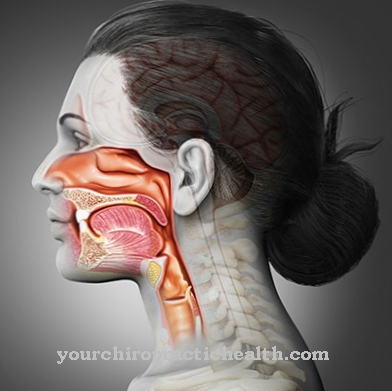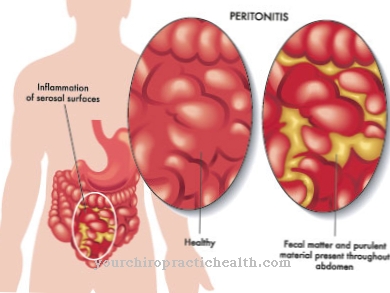The term Storage disease refers to a group of diseases that are characterized by deposits of various substances in organs or cells. Storage diseases include, for example, lipidoses or hemosideroses.
What is a storage disease?

© auremar - stock.adobe.com
Storage diseases can appear in different forms and characteristics. However, what all diseases have in common is that substances are stored in cells and organs. Depending on the place of deposit and the substance, different symptoms arise. In glycogenoses, glycogen that is stored in the body tissues is only partially broken down. Glycogenoses include, for example, Hers disease or Pompe disease.
In mucopolysaccharidoses (MPS), glycosaminoglycans accumulate in the lysosomes. MPS therefore belong to the group of lysosomal storage diseases (LSK). These include the Hunter syndrome or the Sanfilippo syndrome.Hereditary metabolic diseases that are associated with an abnormal accumulation of fats in tissue and cells are summarized under the collective term lipidoses.
Typical lipidoses are Wolman's disease and Niemann-Pick disease. Sphingolipidoses are inherited storage diseases in which there is an accumulation of sphingolipids in the cells. Fabry disease or Gaucher disease are sphingolipidoses. Hemosideroses are among the most well-known storage diseases. In hemosiderosis, iron is deposited in the body. In amyloidoses, there is an intracellular and extracellular deposition of protein fibrils.
causes
Many storage diseases are hereditary. Glycogen storage diseases are usually based on an enzyme defect. In von Gierke's disease, for example, the glucose-6-phosphatase is damaged, in Tarui's disease it is the phosphofructokinase. The majority of mucopolysaccharidoses are also inherited. There is a lack of enzymatic cleavage of the glycosaminoglycans and thus an accumulation in the lysosomes of the body cells.
Many lipidoses are due to reduced or defective function of the lysosomes. Therefore the liposes are assigned to the lysosomal storage diseases. Mutations in the genes that encode the lysosomal enzymes lead to a complete loss of activity. This disrupts fat metabolism and the lipids accumulate in the tissue.
Like liposes, sphingolipidoses are also based on lysosomal enzyme defects or on enzyme deficiencies. Hemosideroses can be acquired or congenital. Acquired hemosideroses occur as a result of increased iron intake. Blood transfusions or transfusions of erythrocyte concentrations, in particular, can cause increased deposits of iron in the body. Hereditary hemochromatosis, on the other hand, is an autosomal recessive inherited disease.
Symptoms, ailments & signs
The symptoms of glycogen storage diseases are quite different. The heart, liver, or kidneys become enlarged. Those affected are often low in blood sugar. The blood lipid levels are increased. Hyperuricemia can also occur. As the disease progresses, hemorrhagic diatheses often develop.
In hemosideroses, iron deposits in the organs cause toxic cell damage. In the liver, hemochromatosis leads to cirrhosis of the liver. The risk of liver cancer also increases significantly. In the pancreas, fibrosis leads to a lack of insulin and thus to diabetes mellitus. In the heart, iron storage leads to cardiac arrhythmias and, in the worst case, to heart failure.
A so-called pseudogout develops in the joints. Men are at risk of infertility. Amyloidoses are associated with increased protein excretion in the urine (proteinuria), neuropathies, dementia, enlarged liver, hair loss and joint problems.
With liposes, too, there is swelling of the liver and spleen. Furthermore, a psychomotor degradation can be observed. In children, developmental disorders, hearing impairments and spasticity appear within the first year of life.
Diagnosis & course of disease
The symptoms, which are usually quite characteristic, provide first indications of the existence of a storage disease. Depending on the suspected diagnosis, various examinations are carried out. Imaging methods such as X-rays, ultrasound, CT or MRT provide information on damage to the organs or on organ enlargement. Various blood parameters such as glucose, creatine kinase, iron or proteins can be determined in laboratory diagnostics.
Which parameters are determined in the laboratory depends on the suspected diagnosis and the symptoms present. A biopsy of the affected organs and tissues can often confirm the diagnosis. In the case of amyloidoses, for example, the phenomenon of ham spleen is found in the biopsy. The appearance of the sliced spleen is reminiscent of a sliced ham due to the storage of the protein fibrils.
Complications
As a rule, the exact complications and complaints of the storage disease depend very much on its severity and also on which components cannot be stored in the cells. For this reason a general prediction is not possible in most cases. As a result of the disease, those affected suffer from severe enlargements of the liver or heart, so that pain can occur in these organs. The kidneys can also be affected by enlargement.
As the disease progresses, the liver is damaged and the person concerned dies. Disturbances in the heart rhythm also occur and those affected can suffer from heart failure. In many cases, the storage disease also leads to psychological complaints and developmental disorders. The disease can lead to severe disorders, especially in children.
The treatment of storage disease always depends on the underlying disease. There are no particular complications. However, if the organs have already been damaged, transplants or surgical interventions may be necessary. The life expectancy of the person affected may be significantly reduced.
When should you go to the doctor?
A storage disease should always be examined and treated by a doctor. Since such an illness does not self-heal, a doctor must be consulted. Only with proper medical treatment can further complications be prevented. In most cases, the patient will need lifelong treatment for storage disease.
A doctor should be consulted if there are problems with the internal organs. In most cases the patient's blood values deviate from the normal values. This can also affect the heart, and in the worst case it can also lead to complete insufficiency, which leads to death. In many cases, hair loss can indicate a storage disease, with children in particular suffering from developmental disorders or even spasticity. If these symptoms occur, a doctor must be consulted in any case.
A storage disease can be recognized by a general practitioner. The further treatment itself then depends on the exact symptoms and their severity and is carried out by a specialist.
Therapy & Treatment
The therapy depends on the underlying disease. Hereditary hemochromatosis, for example, is treated with bloodletting therapy. Instead of bloodletting, blood donation can also be carried out regularly. Alternatively, the drug deferoxamine is used. An iron-poor diet can also have a positive effect on the course of the disease. If detected in time, patients with hemochromatosis have a normal life expectancy.
Amyloidoses are treated with diuretics, ACE inhibitors, CSE inhibitors and amiodarone. Patients may also need dialysis. It may also be necessary to use a pacemaker. In the case of lipidoses, causal therapy is often not possible. Depending on the form, the patients die in childhood.
Symptomatic therapy aims to prevent the absorption and accumulation of fats and cholesterols. Statins are used for this, for example. With many storage diseases it is important that therapy is started before the onset of the first symptoms. The course of the disease can often be positively influenced in this way. Very few storage diseases are curable.
You can find your medication here
➔ Medicines for painprevention
Since most storage diseases are inherited, prevention is not possible. Only the acquired hemosiderosis can be prevented through controlled transfusions and a balanced supply of iron.
Aftercare
In most cases, the options for direct follow-up care for a storage disease are limited. In many cases the disease itself cannot be treated causally, as it is very often a genetic disease. Therefore, the person affected should ideally see a doctor very early.
If you want to have children, a genetic examination and counseling should first be carried out in order to prevent the recurrence of the storage disease. It cannot heal independently either, so that the person affected should contact a doctor at the first symptoms and signs of this disease. In most cases, this disease can be relieved relatively well by taking various medications.
Regular consumption and the prescribed dosage must always be observed in order to limit the symptoms properly. A doctor should always be consulted first if you have any questions or if you have any side effects. Regular controls and examinations are also very important in order to regularly check the current status of the storage disease. If the storage disorder is treated, the life expectancy of the patient is usually not reduced.
You can do that yourself
Any situation of overload or physical strain must be avoided in everyday life. At the first signs of excessive demands, the person concerned needs rest and protection. Taking regular breaks helps to prevent any discomfort. The disease represents a challenge for the organism in coping with it.
As part of self-help, everything should therefore be done to build up situations of relief. Stressors are to be avoided and emotional stability is important. Both of these help to reduce cardiac rhythm disturbances to a minimum. At the same time, the pressure on organs or functions of the organism decreases. Relaxation techniques such as yoga or meditation help to create inner stability.
If the disease progresses unfavorably, the life expectancy of the person affected is reduced. Therefore, the person concerned should inform himself sufficiently in advance about the possible developments and take any precautions. This leads to mental states of overload being reduced under certain circumstances.
The diet should be checked and, if necessary, optimized. The intake of fats and cholesterol should be avoided, as these lead to an increase in symptoms. Eating a healthy and balanced diet will help alleviate the health problems. In addition, sufficient exercise in fresh air is also beneficial for stabilizing the body's defense system.





.jpg)






.jpg)



.jpg)










.jpg)
